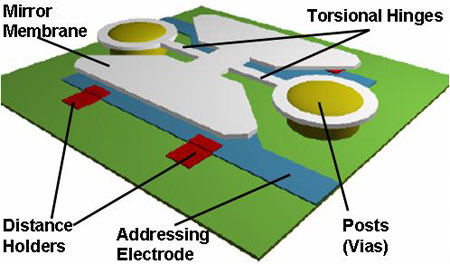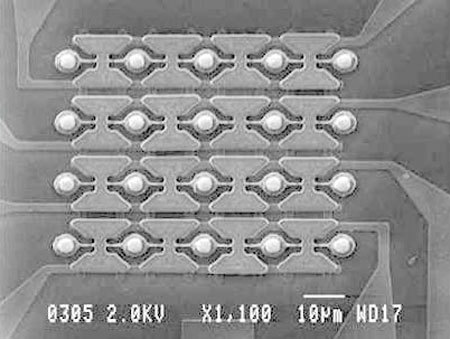IC Integrated Mono-Crystalline Silicon Micro-Mirror Arrays
In this project, large arrays of IC integrated mono-crystalline silicon micro-mirror arrays for maskless lithography systems and adaptive optics systems are developed.
XXXX–XXXX

The main application areas of micro-mirror arrays are projection display systems, pattern generators in maskless lithography systems, optical scanners, printers, optical spectroscopy, aberration correction, adaptive optical systems and switches in optical communication systems. Some of these applications require large two-dimensional arrays of individually addressable micro-mirrors. Micro-mirrors that are made of mono-crystalline silicon have several advantages. The mechanical stability of mono-crystalline silicon is superior over metals. There are no re-crystallization effects due to material deformation in mono-crystalline silicon hinges. This minimizes hysteresis and memory effects as a result of repeated or prolonged micro-mirror actuation. Also, the achievable flatness due to the extremely low-stress mono-crystalline material, the optical quality, the surface roughness and the uniformity of the silicon surfaces is superior compared to most other surfaces. However, mono-crystalline silicon micro-mirrors can not be monolithically integrated on CMOS wafers.

In this project we develop large arrays of IC integrated mono-crystalline silicon micro-mirrors for maskless lithography and adaptive optics applications. For the micro-mirror integration, the 3D integration platform at KTH-MST is used.
The Figure shows a small micro-mirror array with 4x4 pixels that has been manufactures using 3D integration. The mono-crystalline silicon mirror membranes are 340 nm thick and measure 16 µm x 16 µm. The hinges are 4 µm long, 600 nm wide and the vias are 3 µm x 3 µm in size. This project is part of an EU-FP6 project called Q2M
Project partners
- Fraunhofer IPMS
- Micronic Lasersystems
- 20/10 Perfect Vision
- IBM
Project members
Selected publications
Niklaus et al., "Arrays of Monocrystalline Silicon Micromirrors..."

